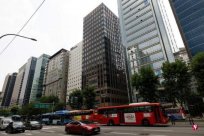
The global real estate market is experiencing shock adjustment. The most powerful vibration is South Korea. House prices that have been plummeted all the way have made many Koreans feel painful.A property in Jiangnan District, a rich man in Seoul, South Korea, once called a property price of 3.2 billion won (about S $ 3.35 million), which has now fallen to 2.35 billion won, a decrease of 26.5%.Many local real estate developers began to fight for new houses, and even promised to buy a house to send Mercedes -Benz (Marseille).Nevertheless, South Korea's house prices still collapsed.According to statistics, the overall house prices in South Korea have fallen for 9 consecutive months, and some apartments in Seoul have dropped sharply by 30%to 40%, but the transaction volume still decreases by more than 70%.
What is more worried about Koreans is that the property market is likely to repeat Japan.Of course, on this question, the first thing to answer is: What is Japan?
Tan Huajie, the former secretary of Vanke, the largest real estate business in China, has been analyzed based on data from 27 countries and regions that can trace the data growth of house prices for more than 20 years.The rise, that is, these countries still follow the classic real estate cycle operation.But he was also surprised to find that Japan was an exception -since the real estate market in this country collapsed in 1991, and to his research, in the past 30 years, it has been in a state of continuous decline, which has created land prices in developed countries for nearly 30 years.The longest record; it is also the only case that has not been recovered after the real estate market bubble breakdown.
For this reason, Harry S. Dent, chairman and founder of the American economist, Chairman and founder of the Harry Dante Foundation, described Japan as a "coma economy".It refers to a patient who has become a straight line in the emergency room into a straight line. Although he has exhausted all kinds of life maintenance methods (such as quantitative easing and even negative interest rates such as stimulus), it is almost unsuitable.EssenceSpecific to real estate, he even used a subtitles such as "rest, rest, Japanese real estate".More importantly, as of now, we still can't see the signs that are about to get out of this dilemma.
So the question is, why can't Japanese real estate get up?Rather than interest rate hikes, but deeper factors may come from population issues.In this regard, there is a need for further understanding of Japanese population issues.
Like most countries, from 1947 to 1949 after World War II, Japan also ushered in the post -war infant.People of this age are known as the "Tuanzhang Generation", and it is the main force of promoting the rapid development of Japan in the mid -1960s to the 1980s.Beginning in 1962, the 15 -year -old group babies began to enter the labor market one after another.As a result, the total labor force of 15 to 64 has been increasing, and Japan's national strength has been increasing. By the late 1970s, some people even thought that Japan was the first world in the world.As far as Americans are concerned, Japan at that time had a considerable threat to it. Some American scholars even believed that the Japanese could not occupy the United States through military power, and now they have to change their economic power to occupy peacefully.Although many social problems have occurred throughout the economy throughout the economy, due to the enhancement of national strength, social problems have been digested in development.The political situation is also stable, and the Prime Minister not only can do full term, but also re -election.
As the Japanese scholar Kobayashi Korima pointed out: "The population dynamics does not happen suddenly, but a little bit, but it really changes in the ground.Click, but it really penetrates. After accumulating for a period of time, changes become obvious, but at first this change is not easy to detect, or people turn a blind eye to this. "
Under the prosperity, there are hidden concerns. The national self -confidence, which has expanded with economic growth, also covers the issues that need to be most concerned.With the development of the economy, the popularity of contraceptive tools and the legalization of abortion, the fertility rate of Japan has continued to decline. As early as 1955 to 1960, Japan entered the threshold2%a little more, just enough to maintain the stability of a total social population.By 1974, Japan's fertility rate was below the level of 2.1 children who maintained the normal population replacement for the first time.By the late 1970s to the early 1980s, Japan began to show the early symptoms of aging, and the population problem began to become prominent.
In Japan, 1992 was an iconic year.This year, the population of a total labor age of 15 to 64 officially entered the inflection point, and then declined all the way.There are also Japan's economy who entered the inflection point with the working age population. Since then, it has been in a state of stagnation for a long time, so that Harry Dante described the trend of the Japanese economy with the "coma economy".In other words, 1992 was the dividing point of the Japanese economy from the demographic dividend cycle to the demographic deficit cycle.
In fact, many analysis of real estate also points to the factors of the population.For example, a review article in the early Hong Kong South China Morning Post believes that although the population of Tokyo is very liquid, the population growth is still difficult to support rising house prices.
What is more important is that the population structure of Japan determines that these old problems are still unable to digest these old problems; from the current population trend, it is difficult to solve these problems in the future.In 2005, the National Institute of Population and Social Security of Japan announced a prediction report that showed that the total fertility rate of women in Japan continued to maintain a level of 1.25 -greatly lower than the level of women's fertility (women's total fertility rate 2.1) -- Then in the next 50 years, the Japanese population will decrease by 30%, that is, by 2055, the Japanese population will be less than 90 million.Extremely aging and extremely low birth rate. In addition, it is not an immigration country, which means that the population growth is weak and there is no actual demand from the local market.
Unfortunately, this is also a big problem that plagues South Korea.
In fact, South Korea may be worse than Japan.The total fertility rate of South Korea in 2018 was 0.98, which is the only country among 37 member states of the OEMs of less than 1, and at the same time, it is the lowest in the world.The average fertility rate of member states of the Economic Organization is 1.63. After 2019, the total fertility rate of South Korea has further declined, only 0.84 in 2020. In 2021, the preliminary statistical results of birth and death in 2021 released by the South Korean Department of Statistics showed that the total of the total of the death population.The fertility rate further dropped to 0.81.As South Korea's low birth rate and aging acceleration have continued, the population of 0 to 14 years old is 12%, which is less than half of the global average (25%).Japan is the same as South Korea and is at the lowest level.In contrast, the proportion of population over 65 years old is 17%, which is higher than 10%of the world average.
Of course, the Central Bank of South Korea raised interest rates on the problem of tamed inflation, and that young people began to lay flat, which was also one of the reasons.
The question is that China and South Korea are still in the same difficulties as China. So is the Chinese property market far away from today's Korean property market?My answer is: far away, not far away.Once the monetary policy enters the interest rate hike cycle and its population cycle factors are superimposed, the Chinese property market will have a high probability that it will follow the day and Han Houchen.



